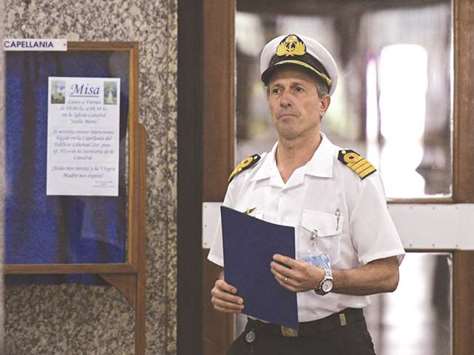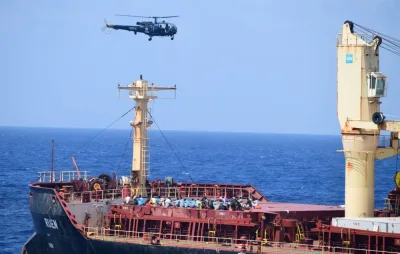The Argentinian submarine ARA San Juan that went missing last week with 44 crewmembers on board may have exploded, the navy said yesterday.
Navy spokesman Enrique Balbi dismissed the possibility of an attack and said the explosion may have occurred inside the submarine without ripping it apart.
The Comprehensive Nuclear-Test-Ban Treaty Organisation (CTBTO), based in Vienna, registered a short, violent, non-nuclear and anomalous event “consistent with an explosion” on November 15, when the submarine disappeared.
The Argentinian embassy in Vienna passed the information to the government in Buenos Aires.
The information is consistent with a “hydro-acoustic anomaly” detected by US sensors and international agencies, Balbi said.
The event took place in the Gulf of San Jorge, about 430km off the coast and 1,300km south of Buenos Aires, three hours after the navy had last communicated with the submarine.
It may have been an “implosion” rather than an explosion, meaning it was confined inside the vessel and did not tear it apart, Balbi said.
A CTBTO statement talked of “a signal from an underwater impulsive event”, meaning that the shock occurred in the water and not on the sea bed.
CTBTO spokeswoman Elisabeth Waechter said that it took her organisation time to transmit its findings because the detected shock was small and therefore difficult to analyse.
“The planet makes noises all the time,” she told DPA in Vienna. “It’s a challenge to filter out relevant sounds from the noise.”
Balbi said the navy had no information on the causes of the reported event, but dismissed the possibility of an attack.
“We don’t have any evidence to confirm that,” he added.
Argentinian media said that a short-circuit in the batteries of the submarine, which it had reported before it went missing, may have caused an explosion.
The navy has so far avoided linking the mechanical problem with the disappearance of the ARA San Juan.
The news plunged relatives of the crew, who have gathered at the naval base of Mar del Plata where the submarine was travelling, into despair.
“They did not say they were dead, but it’s logical to think that,” said Itati Leguizamon, the partner of one of the crew members.
“Those perverse wretches manipulated us,” she added, accusing the government of having “abandoned” the navy.
Some relatives accused the navy of having initially kept the alleged explosion secret.
The ARA San Juan had already suffered a mechanical problem at sea in 2014, the wife of one of the crew members told the broadcaster TN.
Signs of support for the relatives have multiplied at the naval base, with placards, images of the Virgin Mary and of Pope Francis hanging there.
Prayers were also held for the crew who have become known as “the 44”, in a reference to “the 33” Chilean miners who were trapped for 70 days and rescued alive in 2010.
Hopes of rescuing the crew before its week’s supply of oxygen ran out had been repeatedly raised and dashed by false alarms triggered by under-sea noises, a lifeboat and flare rockets, all initially thought to have come from the submarine.
Nearly 4,000 people from 10 countries are combing the southern Atlantic with vessels and aircraft.
A remote-controlled underwater vehicle from Norway and a mini-submarine from the US were due to join the search, which will now focus on the area where the alleged explosion occurred.
Sea depth in the area varies from 200m to 3,000m.
The 65m-long, 30-year-old ARA San Juan was able to go down 300m.
Wind gusts blowing at 80kph and 5m waves are hampering the search.

Navy spokesman Captain Enrique Baldi says the navy had no information on the causes of the reported event, but dismissed the possibility of an attack.


